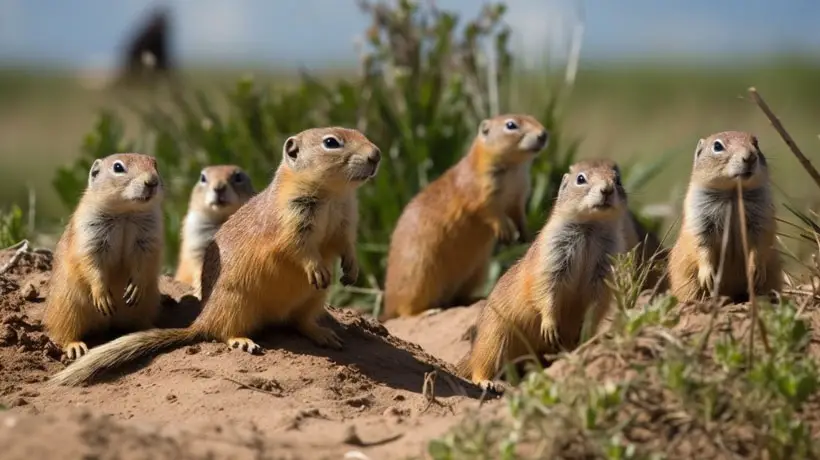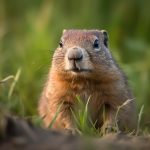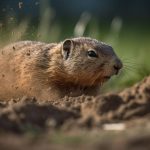How Many Gophers Live Together And How It Affects Their Behavior
Gophers are subterranean rodents that build tunnel networks to live. These tunnels can be spread across about 2,000 sq. ft. and about 6 ft deep. Gophers have multiple layers in these tunnels to use as nesting zones, food storage areas, drainage areas, etc.
The size of gopher colonies usually depends on age, food sources, habitats, etc. You might ask how many gophers live together, and the answer is generally one. Gophers prefer to live alone, so you might only find one gopher inside the burrow system when it isn’t the mating season.
But in the mating season, male gophers invite females to their burrows for breeding. After the gestation period, gopher parents rear their pups for a few weeks. During this period, the population inside a burrow system can rise up to 7-8.
Remember, this can vary depending on the season, food sources, etc. In this guide, we will discuss gopher habitat and gopher social behavior along with their colony size. And you can only take effective steps for garden pest control when you understand their social behavior, infestation timeline, and population density.
Gophers’ Social Behavior
Gophers are fossorial animals, which means they spend most of their lifetime underground. To live beneath the surface, they dig burrows with multiple layers and entrances. Generally, one gopher lives in the burrow system unless it is the mating season.

You might already know about their digging behavior. They build underground burrows to protect themselves from enemies, store food, and use them as nesting areas.
These burrow systems can be about 2,000 sq ft wide. The first layer of the burrow system is usually the main tunnel or runway. Gophers use lateral entrances from multiple sides to enter these tunnels. Storage chambers are usually located on this level. They also have separate chambers for nesting, excretion, etc.
Territorial Behavior and Communication
Gophers are territorial when it comes to protecting their tunnel systems. They usually plug the entrance holes so that other animals or gophers can’t enter the tunnel.
When they meet other gophers outside the burrow, they might squeal to communicate with friends. In the mating season, they might make lower-pitched sounds to attract females.
But when they sense enemies around, they can be really vocal. Though they usually live alone in burrow systems, they might use a loud voice to warn partners and the young.
Gophers also have excellent sensory ability to detect scent. When foraging for food outside their holes, they might use that ability to detect predators. And when new gophers want to invade their holes, they will figure that out by marking scents.
Gopher Social Behavior Based on Habitat and Species
The territorial behavior of gophers might not vary that much, no matter the habitat. Even if they live in a big burrow system, they will tend to protect their territory from others. Among 13 gopher species available in the United States, almost all species are shy. So they will avoid interacting with other gophers in the vicinity.
And when gophers face enemies, whether in your garden, lawn or in the wild, they will try to flee away very quickly. Besides, they will continue to warn other members of the burrow system.
Gopher Colony Size
Gopher colonies can become anything from tiny to enormous. They might take about 20 sq feet of area to build their burrow systems if your garden or lawn is too small.
But if they find an available area, their burrow systems can grow up to 2,000 sq feet wide. Gophers tend to dig at various depths, depending on the risks, food sources, and seasons.

When a male gopher is young, it might live alone in the burrow system. They aren’t very social and tend to build their own burrows for foraging or nesting.
But as they grow and reach the mating age, they might invite female partners into their burrows. When they give birth to a litter, the number of gophers living together can go up to seven.
Gopher Colony Size Variation Based on Habitat and Food Availability
Having food sources near tunnels is crucial for gophers. They need food sources close to one body length away from the hole opening.
It helps them easily munch on juicy crops without being exposed to predators. And if they sense any predators around, they can quickly hide inside their burrows.

If the number of predators is high in a habitat, gophers will tend to build more entrances and exits to confuse enemies. And the colony size will be larger so that they can keep safe.
When food sources are plentiful, they will build large colonies. But if you do regular lawn maintenance, the gopher population in the colonies will shrink.
Understanding Gopher Colony Size for Pest Control and Wildlife Management
Natural pest control becomes easier when gopher holes are limited in your garden. You can set up a few traps or attract predatory birds to reduce the gopher population.
It will help you reduce plant damage and improve soil quality. Otherwise, wildlife management in your garden will be challenging. So, you must understand gopher colony size before eliminating garden pests.
Gopher Infestation Timeline
Unlike some other rodents, gophers don’t hibernate in winter. It means they are active almost throughout the year. And they can infest at any time of the day. Gophers are active around the day and night. But they will prefer dusk and evening. The activity levels get a bit reduced in winter, though. In the summer, the soil can be too hard for gophers to dig burrows. The rainy season isn’t suitable for digging holes either.

They need to have enough ventilation through pores in the soil. The soil composition is perfect in fall and spring. So, gophers tend to build their burrow systems during this period. And if they don’t find safe habitats anywhere, they can even infest your garden or lawn in summer or winter.
Understanding Gopher Activity in Different Stages
The pest control methods you need to use aren’t the same in all stages of gopher infestation. When the infestation is in the primary stage, you will see a few fresh soil mounds in your lawn or garden.
This indicates gophers have just started building their tunnels. In this stage, it is easier to use lethal traps or predatory animals to reduce the gopher population.

But if the soil mounds are dry and large in number, it means gophers have established themselves inside the burrows. It is now tricky to catch them down. So, you need to use natural pest repellents to prevent them from coming out of their holes.
You can also use garden fencing techniques to prevent root damage from below the ground. So, understanding the gopher infestation timeline and identifying their activity is crucial to follow the right wildlife management practices.
Impact of Gopher Colony Size on Plant Growth
When gophers infest your lawns or gardens, they bring some changes to the soil quality and plant growth. After gophers start digging holes in the garden, the top layer of the soil can become unstable. As a result, plants having roots in the top layer can be affected.
Water distribution in the garden is also affected due to gopher tunnels. When you water your gardens, the soil has a specific rate of absorbing the water. But if there are gopher holes in the garden, a lot of water is drained through the gopher holes before the soil can absorb them.

As a result, the growth and stability of plants get reduced after gopher infestation. But gophers may do some good by mixing soil layers. The higher the gopher colony size, the more damage it will cause to your garden.
Companion planting can help weak plants have a stable base to grow. Before you use this method, learn more about plant physiology to understand which plant is a good companion for other plants.
For example, you can plant basil or carrot as companion plants with tomatoes. Planting marigolds can also be a good option. It is a natural pest repellent and effectively deters garden pests.
Understanding Gopher Colony Size to Protect Gardens and Lawns
Before you use any pest control techniques, understanding wildlife behavior is important. When the gopher colonies in your garden are small, you can use non-lethal pest control methods to eliminate infestation. But when the colony size is large, those methods might not be very effective.
You need to implement lethal methods to remove the gopher infestation completely. These methods include lethal traps, garden fencing, etc. Many might suggest drowning or poisoning gophers, but that won’t be a good idea. Watering large colonies might make the whole layer of soil weak. And poisoning can affect your pets or other non-pest animals.
Gopher Trapping and Removal Strategies
Gopher removal can be a challenging process if you don’t know the actual colony size or proper removal strategies. Here is a brief overview of various gopher removal methods for different colony sizes for different aspects.

- Live trapping – You can use metal traps to catch gophers live. After catching them, relocate them to a distance. This method is suitable when the gopher colony size is small.
- Natural repellents – Natural pest repellents might not eliminate gopher infestation, but they will keep gophers at bay. You can use peppermint oil, ground coffee, or Tabasco sauce as natural repellents. And these will work when the colony size is small.
- Lethal traps – Laying traps with lethal baits can help remove gophers from your garden or lawn. And this method is effective when there are too many gophers in your garden.
FAQs
Check the answers to some of the frequently asked questions about gopher colonies and prevention methods.
Q: How do I know if I have a gopher colony on my property?
A: If there are gopher colonies on your property, there will be mounds of soil adjacent to hole openings. Besides, you may experience damaged plants and roots.
Q: Can gopher colonies coexist with other animals?
A: Gophers are solitary animals, so the chance of other animals coexisting in gopher colonies is low. But sometimes, other rodents can temporarily use gopher colonies.
Q: How can I prevent a gopher colony from forming?
A: Using metal barriers at the perimeter of your garden can prevent gophers from digging holes in your garden. You can also use natural or chemical repellents around the garden.
Conclusion
Gophers are small rodents that live underground and feed on plants in your garden. They build a network of tunnels in several layers to live, store food, and protect themselves from predators. These tunnels can be about six feet deep and spread across about 2,000 sq feet.
Despite the enormous size of these tunnels, gophers usually live alone in burrows. But during mating seasons, they will live with partners and give birth to two or three liters per year. The population in gopher colonies could rise at that time.
Large gopher colonies can severely impact plant growth and soil quality. So, you must take steps to control the gopher population in your lawn or garden. And understanding their colony structure, social behavior, etc., is essential to take the most effective steps for pest control.
Learn more about gopher behavior and natural pest control methods to implement the most effective method. Take the pros and cons of methods into consideration to choose the right method depending on the gopher colony size in your garden.




